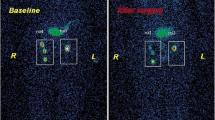Abstract
The repair of common bile duct injuries is a complex procedure with a significant rate of postoperative morbidity and mortality. The aim of this study was to demonstrate the usefulness of the autologous vein graft in replacement of the bile duct. Twelve male Sprague-Dawley rats weighing 350 +- 550 g were used in the study and were divided at random into two groups: the control group (60) and the experimental group in which a 3-mm segment of the bile duct was resected and the biliary tract was replaced by a segment of vein aided by stent (G1). Both groups were subdivided into pairs of rats to study at 30, 60, and 120 days. All of the animals underwent radioisotope cholangiography, a repeat laparotomy, and blood tests for further pathologic study. The clinical evaluation and biochemical nuclear medicine and pathologic studies showed no evidence of cholestasis. The histologic study of the graft showed replacement of the endothelium by biliary-appearing epithelium. The use of an autologous vein graft with a supporting stent proves to be a feasible and alternative procedure for bile duct reconstruction. Further experimental studies should be carried out to validate these findings so they can be implemented in clinical cases.
Similar content being viewed by others
References
Lillemoe KD, Melton GB, Cameron JL, et al. Postoperative bile duct strictures: Management and outcome in the 1990s. Ann Surg 2000;232:430–441.
Buell JF, Cronin DC, Funaki B, et al. Devastating and fatal complications associated with combined vascular and bile duct injuries during cholecystectomy. Arch Surg 2002;137:703–710.
Chapman WC, Abecassis M, Jarnagin W, Mulvihill S, Strasberg SM. Bile duct injuries 12 years after the introduction of laparoscopic cholecystectomy. J GASTROINTEST SURG 2003; 7:412–416.
Morgernstern L, Wong L, Berci G. Twelve hundred open cholecystectomies before the laparoscopic era: A standard for comparison. Arch Surg 1992;127:400–403.
The Southern Surgeons Club. A prospective analysis of 1518 laparoscopic cholecystectomies. N Engl J Med 1991;324:107108.
Deziel DJ, Millikan KW, Economou SG, Doolas A, Ko S, Airan MC. Complications of laparoscopic cholecystectomy: A national survey of 4,292 hospitals and an analysis of 77,604 cases. Am J Surg 1993;165:9–14.
Li JY, Zhang F, Moon W, et al. Biliary tract reconstruction using an autologous vein graft in rats. J Reconstr Microsurg 2000;16:51–55.
Karaayvaz M, Ugras S, Güler O, Aydin M, Alkan I, Yigit MF. Use of an autologous vein graft and stent in the repair of common bile defects: An experimental study. Surg Today 1998;28:830–833.
Wittrin G, Clemens M, Arndt M, Rühland D. Choledochusersatz durhr ein autologes. Venetransplantat Res Exp Med 1978;173:95–103.
Kasui K. Experimental biliary reconstruction with a Dacron graft which preserves the function of papilla Vater. Hokkaido Igaku Zasshi 1996;71:599–609.
Gomez NA, Alvarez LR, Mite A, et al. Repair of bile duct injuries with Gore-Tex vascular grafts: Experimental study in dogs. J Gastrointest Surg 2002;6:116–120.
Shinozaki T, Watanabe H, Takagishi K, Pritzker K. Allotype immunoglobulin enhances alkaline phosphatase activity: Implications for the in.ammatory response. J Lab Clin Med 1998;132:320–328.
Heistermann HP, Palmes D, Hierlemann H, et al. Reconstruction of bile duct lesions by an autologous vein graft and a bio-degradable endoluminal stent in an animal model: Technique and clinical impact. Zentralbl Chir 2003;128:952–957.
Author information
Authors and Affiliations
Corresponding author
Rights and permissions
About this article
Cite this article
Capitanich, P., Herrera, J., Iovaldi, M.L. et al. Bile duct replacement using an autologous femoral vein graft: an experimental study. Preliminary results. J Gastrointest Surg 9, 369–373 (2005). https://doi.org/10.1016/j.gassur.2004.09.024
Issue Date:
DOI: https://doi.org/10.1016/j.gassur.2004.09.024




